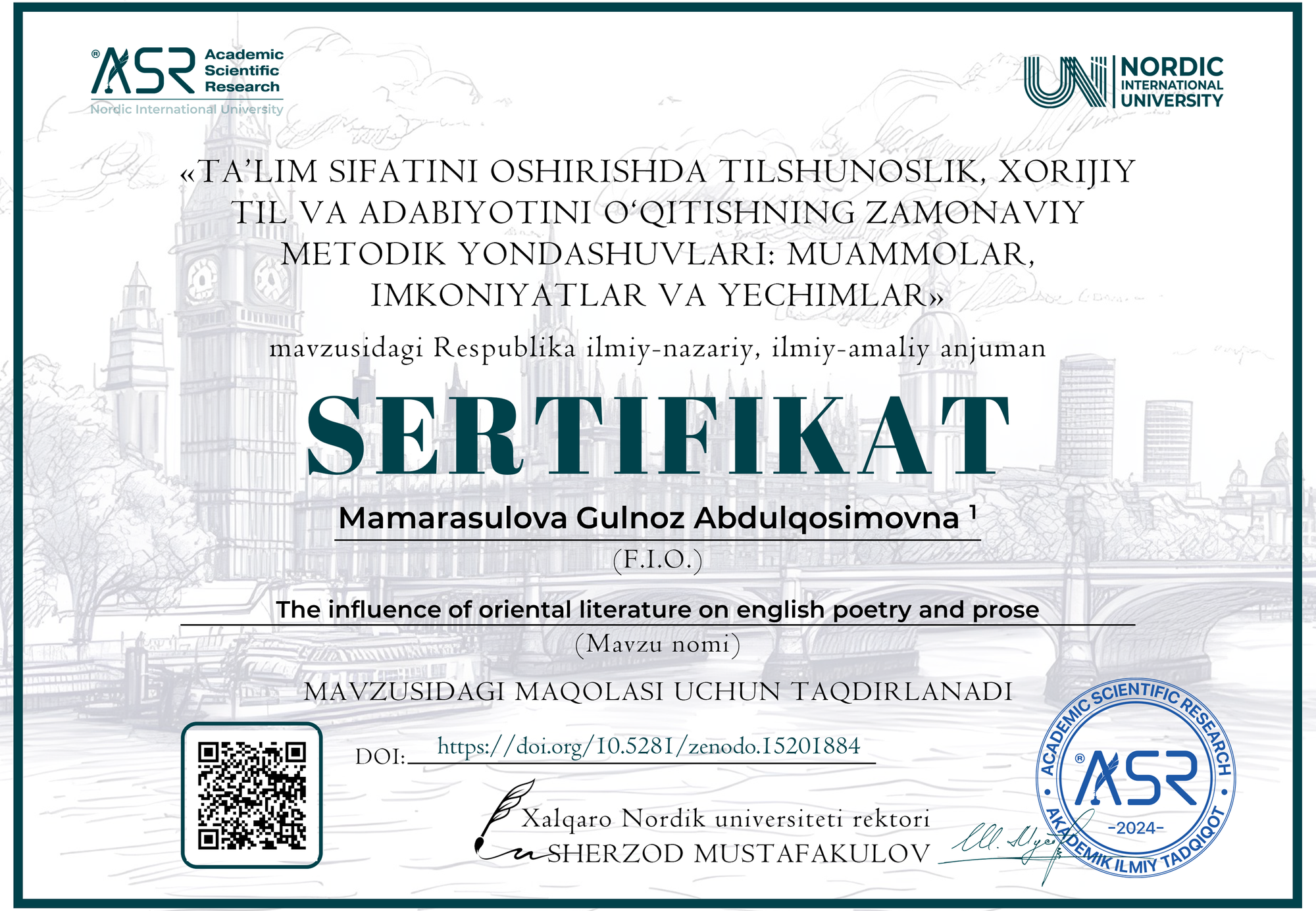Mamarasulova Gulnoz Abdulqosimovna1

DOI: https://doi.org/10.5281/zenodo.15201884
Google scholar: https://scholar.google.com/scholar?hl=ru&as_sdt=0%2C5&q=%22THE+INFLUENCE+OF+ORIENTAL+LITERATURE+ON+ENGLISH+POETRY+AND+PROSE%22&btnG=
Zenodo community: https://zenodo.org/records/15201884
Nordic_press journal: https://research.nordicuniversity.org/index.php/nordic/article/view/2343
MAQOLANI YUKLAB OLISH
SERTIFIKATNI YUKLAB OLISH
REVIEW:
In her scholarly work, Dr. Gulnoz Mamarasulova provides an insightful and well-researched exploration of the significant influence of Eastern literature on English Romantic poetry and prose. The article delves into how major Romantic poets such as Samuel Taylor Coleridge, Lord Byron, and Percy Bysshe Shelley drew inspiration from the mysticism, exoticism, and spiritual traditions of Persian, Arabian, Indian, and Chinese literary cultures. By examining this cross-cultural exchange, Mamarasulova highlights the complex interplay between Western and Eastern thought, shedding light on the rich tapestry of Orientalist themes that defined much of Romantic literature.
The paper’s main contribution lies in its comprehensive analysis of Oriental motifs like mysticism, exotic landscapes, and the "Other" that permeated the works of Romantic poets. By investigating the ways in which Eastern philosophy, spirituality, and narrative techniques were adapted by poets, Mamarasulova reveals how these poets sought to escape the rationalism of the Enlightenment and engage with the sublime and the mysterious aspects of the East. This fascination with the Orient, often romanticized and steeped in stereotypes, was a means for Romantic poets to challenge Western materialism and explore ideas of transcendence and spiritual unity.
The article effectively contextualizes the literary works of Coleridge, Byron, and Shelley within the broader framework of Orientalism, as later defined by Edward Said. Mamarasulova provides a nuanced understanding of how these poets appropriated Eastern elements, not just as exotic backdrops but as vehicles for deeper philosophical engagement. For instance, Coleridge's Kubla Khan, with its dreamlike imagery and blending of Eastern symbols with Romantic introspection, stands as a prime example of how Eastern literary traditions were adapted to explore themes of creativity, spirituality, and the fragility of inspiration. Byron’s The Giaour and The Corsair similarly present the East as both a source of passionate intensity and a critique of Western imperialism, using Eastern characters and settings to explore complex notions of identity, morality, and fate.
The paper also draws attention to the distinct narrative and poetic techniques that Romantic writers borrowed from Eastern literature. For example, the use of nested stories and fragmentation in Eastern works like The Arabian Nights influenced the structure of poems such as Coleridge’s Kubla Khan and Byron’s The Giaour. Moreover, the influence of Persian poetry, particularly the emotional intensity and lyrical beauty of Sufi works, is evident in the Romantic poets' depiction of nature, longing, and divine love. Shelley’s Ode to the West Wind and To a Skylark, echoing the ecstatic lyricism of Sufi poetry, exemplify this deep connection to Eastern aesthetic and philosophical ideals.
Mamarasulova’s comparative approach to Eastern and Western literary traditions is another strength of the article. By charting the thematic, stylistic, and philosophical parallels between Eastern literature and English Romanticism, the article highlights how the Romantic poets' engagement with the Orient was not only an aesthetic choice but a philosophical one as well. The paper draws on specific examples such as Coleridge’s "sacred river" in Kubla Khan to illustrate how Romantic poets transformed Eastern motifs into profound metaphors for the human psyche, while also critiquing Western rationalism and materialism.
In addition to its literary analysis, the article references relevant scholarly sources, such as Edward Said’s Orientalism, Michael J. Franklin’s biography of Sir William Jones, and Ferial Ghazoul’s The Arabian Nights in Transnational Perspective, which provide a rich backdrop for understanding the historical and cultural contexts that shaped the Romantic poets' fascination with the East.
The inclusion of a comparative graph to illustrate the cross-cultural influence between Eastern themes and English Romanticism further strengthens the article’s analytical approach. This visual aid helps to concretely highlight how themes of mysticism, exoticism, and transcendence in Eastern literature found their echo in the works of the Romantic poets, offering readers a clear and succinct way to visualize the intricate connections between the two literary traditions.
In conclusion, Dr. Mamarasulova’s article provides a thorough and nuanced examination of the influence of Eastern literature on English Romanticism. By exploring how poets like Coleridge, Byron, and Shelley incorporated Eastern motifs into their works, she demonstrates how these literary traditions not only enriched Romantic poetry but also served as a vehicle for broader philosophical and cultural critiques. This paper makes a valuable contribution to the ongoing study of Orientalism in literature, offering new insights into how cross-cultural exchanges shaped the intellectual and artistic movements of the 19th century.



